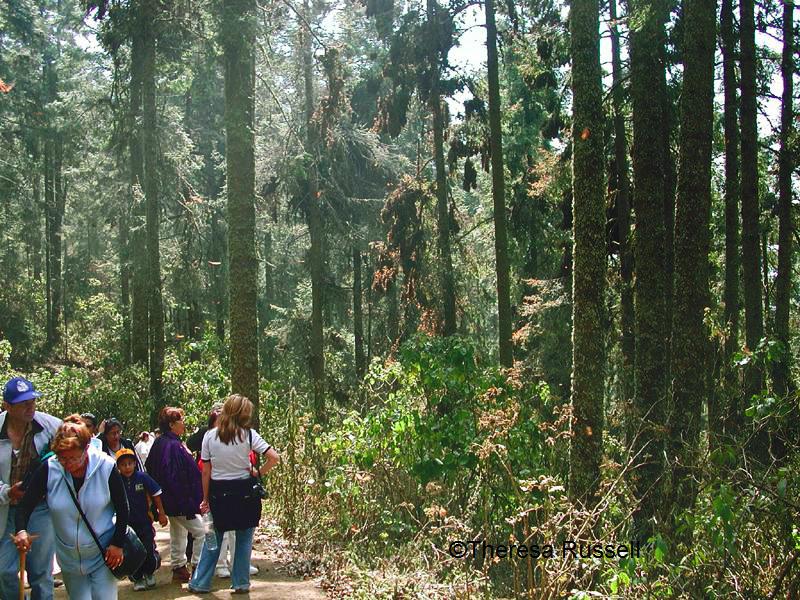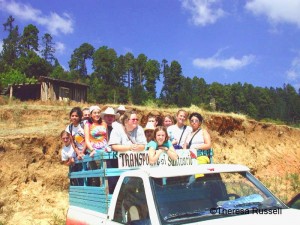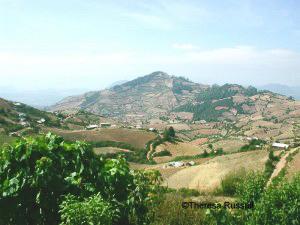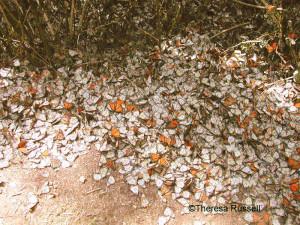By Theresa Russell
Every year monarch butterflies migrate south from the northern reaches of the eastern US and southern Canada, returning to the same destination in Mexico. The mystery of it all even more intriguing since its not the same butterflies making the return journey; their life span is too short. In fact, the returning butterflies are several generations removed from those that made the journey the previous year. Scientists keep busy trying to define the mechanism that gives these orange and black flyers the ability to get to the oyamel forests in the state of Michoacán, Mexico.
In Search of Monarchs
Intrigued by this phenomenon and always eager for an excuse to go to Mexico, I boarded a plane to Mexico City. My arrival did not coincide with the schedule of the direct bus to Angangueo, the launching point of the trip up into the mountains to the butterfly sanctuary El Rosario, one of four open to the public, and the most visited. My journey involved first going to Zitácuaro and taking a bus to Angangueo, a former mining town with a certain charm. From there, I hired a driver to take me to the reserve. Trucking it to El Rosario monarch butterfly reserve.
Trucks wait in the square to transport visitors up the scenic and potholed road up the mountain to El Rosario. The ride itself is a forty-minute adventure and standing in the back of a pick-up truck is the perfect spot for taking shots of the surrounding vista.
Deep into the Oayamel Forest
A small village appears. Smoke puffs from rustic stoves and smells of maize waft through the chill air. At this elevation, the temperature is cooler and those not acclimated will quickly notice the effects of altitude as well, especially when climbing up the hill to the best vantage point to see the butterflies. I fully expected to see the butterflies when we reached the village, but nary a one fluttered by. I passed by the stands with locals selling food like steamed corn on the cob and beverages and grabbed a hot chocolate to take off a bit of the chill. The locals who run these stands live in poverty and have agreed to give up logging rights to the forest, the nesting place of the monarchs. They are concerned with their own survival and need adequate wood supplies for heating and cooking. The choice between personal survival and saving the monarchs is an easy one for them so several groups are donating money and helping the locals earn money from tourism. Another group helps with the planting of trees so that these humble people have a source of heat.
Awe Inspiring
At the end of the village the entry to the sanctuary appears.
I pay the small admission fee and start walking through the woods focusing my eyes on the trees hoping to see the monarchs. The pathway climbs continuously for over a mile. I notice the women in high heels showing not one bit of discomfort plodding up the hills. Most of the visitors here are Mexicans. The temperature has dropped quite a bit from what it was down in Angangueo and even with the effort of climbing warming me up, I still find it necessary to put on my gloves and cover my ears. Finally, I see a group of people speaking in whispers and gazing up at the trees. The pilgrimage to see the butterflies is quite spiritual. A sense of wonderment and respect fills the air. A butterfly alights on the nose of an observer and everybody gathers around and quietly watches the star of the day.
An orange and black tufted carpet resembling a moss covers the trees in the forest. It is the monarchs clumping together waiting for the weather to warm. I made the mistake of getting to the sanctuary early in the day, only because I had to catch a bus. The butterflies quiver when they are warm enough, but until then huddle in the trees. Slowly they leave their roosts and flutter through the air much to the delight of the onlookers.
Worth Multiple Visits
I returned the next season with a group of high school students who had volunteered for a month in Querétaro. Once again we hired a pick-up truck for the ride to the sanctuary. Some things had changed over the year. Some of the steeper more treacherous parts of the path had been replaced with stairs, making the trip a bit easier. Having spent a month at high altitude, I found the climb less fatiguing and breathed a bit easier even though the 10,000 feet altitude was twice as high as I had grown accustomed to. This winter had been chilly.
More butterflies were lying motionless on the ground resembling piles
of raked autumn leaves than were nesting in the trees. Some people said that they were sleeping. They were actually dead. The cold weather was more than they could handle. Those that did survive drew even more awe from the viewers. A butterfly landed on a child’s hand and a group quickly gathered to observe. Something so simple elicited such a strong response. “Mariposa monarca”, echoed through the crowd.
Several years ago, an intrepid ultra light pilot, Vico Guitterez, followed the monarchs to Michaocan in his appropriately named vehicle, Papalótzin, the Nuahtl word for venerable butterfly. In the US, the butterflies are finding their milkweed stores being depleted and are also suffering the effects of chemicals used on corn. You can follow the route and learn all about the project here. If you would like to learn more or get involved with tagging butterflies, visit Journey North for more information.
The number of butterflies in any given year varies depending on weather and other environmental factors. The season is from November until mid March when the return flight starts. The towns of Angangueo, Ocampo and Zitácuaro hold butterfly festivals in February, which is a good time to view the butterflies because they start leaving their nesting sites creating swirls of color in the air.
If you go:
Most major airlines fly into Mexico City. From there, rent a car or take the bus. Most buses leave from the Observatorio station (Mexico City has four main bus stations.)
American, United, Volaris, Delta and Aeromexico fly in to Morelia.
Tours -There are several tour operators who go to the butterfly sanctuaries.
If you go early in the day, there will be fewer tourists, but little butterfly activity. Warmer temps bring out more flying butterflies and tourists.
El Rosario is open from 9am-6pm.
Hotels in Zitácuaro, Angangueo and Morelia, a fabulous colonial city and UNESCO site.
Tourist info -www.visitmexico.com
About Theresa Russell
Claiming her lust for travel began on her first journey through the birth canal, Theresa is genetically programmed to travel and to have fun doing it. She especially enjoys adventure and experiential travel and always finds something at a destination to write home about.




